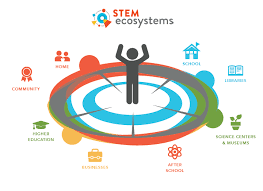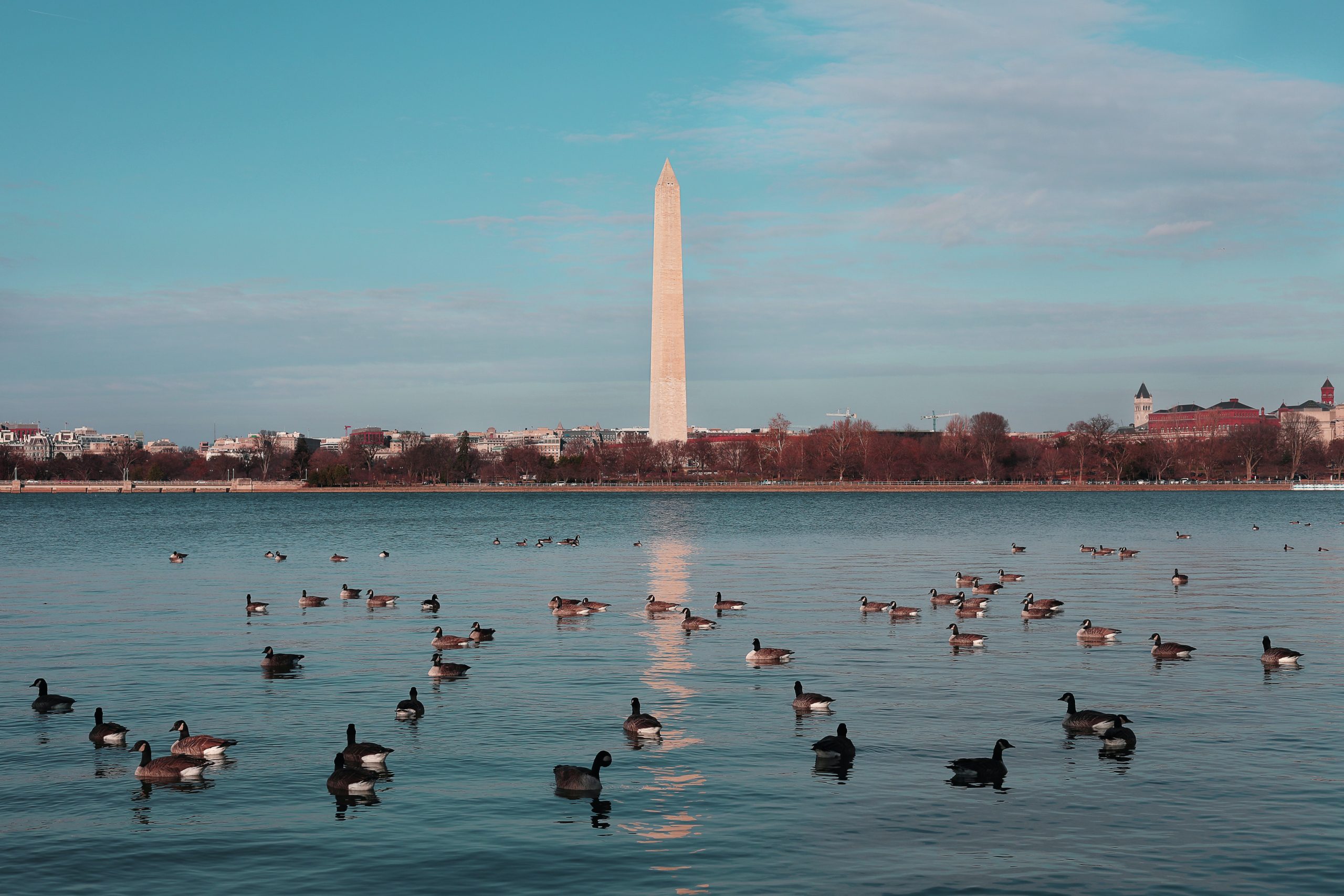A lot of new legislation has been passed recently and it can feel a bit like sinking into the alphabet soup of acronyms coming from Washington, D.C. We are also in back to school season, with kids and educators heading back to now open school buildings, hoping to return to some sense of normal. We are prioritizing in-person connections and relationships again.
STEM Next is a thought leader partner and facilitator of resources and funding that understands the important role of out-of-school time STEM learning opportunities. As an advocate of the power of STEM learning beyond the classroom and an active supporter of the Afterschool STEM Hub hosted by the Afterschool Alliance, STEM Next hopes to make connections for leaders in the field to tap into the resources provided at federal and state levels of government.
With this in mind, STEM Next’s new Director of Policy wants to give us the highlights of what we should know and pay attention to for the coming weeks. With a middle school math teacher for a mother and engineer for a father, Melissa Moritz, grew up doing math problems at the dinner table for fun and has made it her life’s mission to make STEM more accessible for all, believing that STEM education is the fastest path to equity in our country.
Moritz joins us right on time to navigate all of the letters coming from D.C. Here’s what you should know:
CHIPS + Science, Inflation Reduction, BiPartisan Infrastructure – Lots of Legislation = Lots of Opportunities
In August 2022, the bipartisan CHIPS and Science ACT of 2022 was signed into law in an effort to strengthen manufacturing, supply chains and national security in the U.S.
There were a lot of really important authorizations in the legislation that have big implications for STEM education, however most don’t yet have appropriations. All of the dollar amounts seen in the legislation are just recommendations right now. There will not be real dollars for anything until things have been appropriated. (Note: the CHIPS portion of the legislation already has appropriations, which means real money given there.)
While we wait to see how much will go where, there is much to be enthusiastic about. The field should be excited that the Education Human Resources Directorate at NSF is now codified as STEM EDU. We should be excited about language to cultivate partnerships and ecosystems that broaden participation in STEM. We should be pumped about codifying NASA’s STEM Engagement Office.

Photo Courtesy of STEM Learning Ecosystems
More specifically, the legislation points to the power of regional collaboration as the mechanism for communities to best meet workforce demands, spur innovation and increase opportunities, especially in STEM fields, that generate economic growth and thriving communities. The power of local partnerships, including STEM Ecosystems and Statewide Networks, create the connections between in – and – out-of-school learning, institutions of higher education, community-based organizations, business and industry, as well as families and government -to more seamlessly teach the skills needed for growing industry, support equitable pathways for all learners, and encourage policy that advances such connections.
Bottom line: You are an expert in your community and what you have to offer the STEM learning and career pathways space is important. Also, you can’t do the work alone, working with local organizations to leverage expertise leads to prosperity for your region.
What you can do right now: Start making plans, so when appropriations happen and grant programs are announced, your community is ready. Don’t start writing your grant proposal yet, but think about the type of work you might execute and plan accordingly. It can be helpful to review prior grantees to agencies and competitions you are interested in applying for as well as joining webinars and other technical assistance opportunities to learn more as the grant programs are announced.
The language in the bill should help spark ideas on the types of ideas that could be funded. It would be useful to ask your team questions like: Is this a program that makes sense for my organization to apply for? Who would be the right partners to work with on this type of project? How can I start those conversations with local partners? Is there an evaluator we would like to work with? Is there an existing project plan or logic model we can look to for inspiration?
Additionally, in the afterschool space, the NSF INCLUDES program, now renamed the NSF Eddie Bernice Johnson INCLUDES Initiative, will be a great opportunity for out-of-school time programs to continue to codify their work. In addition to asking yourself the questions above, it will be important to identify the research question you are looking to address, as the National Science Foundation is all about the research question.
Finally, workforce development implications. These will come from the Bipartisan Infrastructure Law, Inflation Reduction Act, as well as the CHIPS side of the CHIPS + Science Act. The President’s Council of Advisors on Science and Technology (PCAST) recently provided feedback on implementation of both the workforce and CHIPS side of the legislation.
What you can do: Provide your feedback when there are opportunities for public comment. Stay informed by signing up for White House and PCAST Communications. It’s important to have our collective voices heard.
There is Still a Ton of ARP Money Waiting to be Spent – Opportunities for STEM Education
Ninety three percent of the $122 billion of American Rescue Plan (ARP) dollars ear-marked for PreK-12 education could be in danger of going back to the federal government if they are not spent by the deadline of September 2024 (read more). Simultaneously, we just received the data that two decades of progress for students in math was “erased” due to the pandemic.
Needless to say there is a lot of untapped potential (See how your state has tapped into ARP funding so far by accessing this tracker).

Photo Courtesy of: olia danilevich
This is an opportunity for afterschool – a space where students are spending 80% of their time – to explore subjects like math in engaging ways. Out-of-school learning organizations have a chance to support their communities with creative and effective ways to spend that money.
These are some of the most flexible dollars we have seen in our history around education, spending. Anything that is authorized under the Every Student Succeeds Act is fair game for funding.
We know that hands-on STEM learning opportunities can often support and accelerate multiple learning goals. Afterschool and summer programs have been consistently shown to increase academic achievement along with many other positive outcomes, including social-emotional well being. Check out the Afterschool Alliance’s Help Kids Recover map for inspiration on how other cities and districts have used federal pandemic relief funding to advance learning objectives and meet needs of students through afterschool and summer programs.
Recommendations for out-of-school-time organizations: Approach school districts as true partners, with easy to implement, turnkey ideas that will add capacity to their efforts, solve a problem that they have and expand access for afterschool and summer programs.
Districts are strapped for capacity, therefore, it might be helpful in some cases to break down your interventions into core components or to think about technical assistance that you could provide, not just programs that your organization runs. What expertise do you hold? Could the district contract you to run their evaluations or other useful services?
Partnerships are and continue to be lifted up as a priority for effective and sustainable strategies to maximize funds for out-of-school time learning. Collaboration is also critical to increase equity within communities. Take the collaboration of Tulsa Public Schools in Oklahoma with a local intermediary organization, the Opportunity Project, that used roughly a quarter of its ESSER II and ARP ESSER dollars to create more before school, afterschool, and summer learning opportunities as an example. The Opportunity Project coordinated more than 80 community and faith-based organizations to provide a range of opportunities and experiences to students in June and August of 2021. The Opportunity Project organized the RFP process, and the district used federal funds to help existing community-based organizations expand programming. District leaders plan to sustain these initiatives into the future by attracting philanthropic and government funds.
Or what about Stamford Public Schools in Connecticut partnering with Stamford Cradle to Career (SC2C), a community-based organization, to assist in coordinating a new universal 6-week summer program for its elementary school students. In summer 2021, SC2C supported the district by managing a planning process in partnership with Stamford Public Schools and Stamford Public Education Foundation to enlist community-based organizations to provide enrichment activities at school sites during the afternoon portion of the program. A total of 14 community-based organizations serving 1,200 students provided programming in sports, arts, and science that ran for 6 weeks in summer 2021.
Want more? Check out the Summer Learning Commitments section from the Department of Education’s Office of Elementary and Secondary Education review of ARP spending.
Overall, thinking outside the box, like a true partner, will help ensure your community keeps the money.
Community Funded Projects
Congress is soliciting requests for earmarks to support community projects again as an opportunity to secure funding for your work locally.
This process was revived in 2021 and a lot of afterschool and summer programs received funds from that first round of community funded projects.
Call to action: Build and strengthen relationships with your elected officials and make sure you are highlighting the impact of your program. Include the number of students and families served locally, the outcomes you are observing and how these contributions are contributing to a thriving community. Invite them to come visit. Share your stories.
You can learn how to navigate this grant process by reading the guidelines and watching virtual workshops (Note: check your representative’s webpage for any state-specific instructions or resources).
A STEM Office at the Department of Education – Coming Soon
Vice President Harris recently asked the Deputy Secretary of Education to develop a plan for building a STEM office in the U.S. Department of Education (ED). This is really critical because it helps to cement the U.S. Department of Education’s focus on STEM educational equity.
What you can do: Follow along with any publicly shared recommendations. If you like what is shared, tell them. Social media is a great way to make your voice heard and federal agencies don’t always get positive press, especially on social media. Tell them what you love and why you are happy they are doing it.
Engaging on social media and continuing to share your great work could also be a great way to keep riding the momentum for The National Partnership for Student Success (NPSS) and Engage Every Student, two critical initiatives for ED.
The National Partnership for Student Success (NPSS) focuses on all the different supports that students need to be successful and engage. This includes tutors, mentors, access to wrap-around services and more.
Engage Every Student is a call to action for universal access to high quality afterschool and summer learning.
More action you can take: sign up as an allied organization for both initiatives and lend your ideas, support, and capacity, especially locally. Follow the conversation. Join the webinars, mailing lists and other opportunities to learn more.
We hope this breakdown of important policy to follow was helpful. We encourage you to share it with a friend, colleague and neighbor. Stay in conversation with us at STEM Next and keep us informed about what you are doing and what you want to learn more about. Continue to build partnerships and think holistically about your plans to contribute to a thriving community. Your work matters and we appreciate you.
***
Melissa Moritz is the Director of Policy for STEM Next Opportunity Fund. Melissa joins the team after serving as the inaugural STEM Next Afterschool and Summer Learning Fellow in the U.S. Department of Education (ED) Institute of Educational Sciences (IES) and Deputy Director of STEM at ED during the Obama-Biden Administration. Melissa strongly believes that STEM is the fastest path to equity in our country and channels her childhood love of math and science into being a strong advocate for STEM opportunities for young people across the country. Melissa is also a mom of young children and enjoys daily science experiments with them, complete with messes and explosions. @melissawmoritz
Ron Ottinger is Executive Director of STEM Next Opportunity Fund and former co-chair of the national STEM Funders Network and the National STEM Learning Ecosystem Initiative. Ron has been a champion for STEM learning throughout his entire career, with a particular focus around building capacity in out-of-school learning since 2004. Ron believes deeply in the power of informal STEM learning to unlock the potential for young people to innovate, create and lead, and to succeed in school, work and life. @STEMNext


